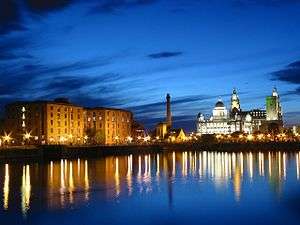Grade I listed buildings in Liverpool
|
The Albert Dock (left) is the largest single collection of Grade I listed buildings in the UK | |
| Listed buildings in Liverpool | |
|---|---|
| Grade I listed buildings | |
| Grade II* listed buildings | |
| Grade II listed buildings: | |
There are over 2500 listed buildings in Liverpool, England.[nb 1][1] A listed building is one considered to be of special architectural, historical or cultural significance, which is protected from being demolished, extended or altered, unless special permission is granted by the relevant planning authorities. Of the listed buildings in Liverpool, 27 are classified as Grade I listed[2] and are recognised as buildings of outstanding architectural or historic interest. The following list provides information on all the Grade I listed buildings in the city.
In Liverpool, several of the Grade I buildings are recognised for their architectural importance, including the Albert Dock, which was the first non-combustible warehouse system in the world; and Oriel Chambers, which was the world's first metal framed, glass curtain walled building. The Liver Building is also recognised as one of the first reinforced concrete buildings constructed in the United Kingdom.
The oldest Grade I listed building in Liverpool is the Tudor manor house, Speke Hall, whose exterior largely dates from the 15th and 16th centuries. A small portion of All Saints' Church dates from the 14th century, although the majority was added later. The newest building on the list is the neo-Gothic Liverpool Cathedral, which wasn't completed until 1980, some 76 years after it was started. Most of the buildings on the list date from the Georgian and Victorian eras, the period during which Liverpool grew rapidly from a relatively small provincial coastal town into one of the most important ports in the world.
Of the 27 buildings in the list, 12 are places of worship, including the city's Anglican Cathedral, six Anglican churches, three Unitarian churches or chapels, a Roman Catholic church and a Synagogue. Five of the remaining 15 buildings in the list are located at the Albert Dock and comprise the largest single collection of Grade I listed buildings anywhere in England.
Grade I listed buildings in Liverpool
| Building(s) | Location | Image | Built | Notes | Coordinates | Ref |
|---|---|---|---|---|---|---|
| Albert Dock Traffic Office | Albert Dock | |
1846-8 | The Dock Traffic Office was constructed at the Albert Dock shortly after the completion of the warehouse buildings. The lower portion was designed by Philip Hardwick and built between 1846 and 47, with the top storey – designed by Jesse Hartley – being added in 1848. The building consists of three storeys above ground and a basement. It is noted of its Tuscan style portico and pediment, which incorporates a 36 ft long, single cast architrave. | 53°24′05″N 2°59′32″W / 53.4015°N 2.9921°W | [3][4][5] |
| Albert Dock Warehouse A | Albert Dock | |
1841–45 | Warehouse A, commonly known as the Atlantic Pavilion,[6] is located at the southern end of the eastern side of the Albert Dock. The warehouse is five storeys tall and 17 bays long, with brick and stone cladding around an iron frame. On the dock facing side, the ground floor is recessed and is lined with doric-style iron columns.(at right in picture) | 53°24′00″N 2°59′28″W / 53.4000°N 2.9911°W | [7][8][9] |
| Albert Dock Warehouses B and C | Albert Dock |  |
1841-5 | Warehouses B and C, commonly referred to as the Britannia Pavilion and Colonnades,[6] are located to the south and west of the dock respectively. Standing five storeys tall, the warehouses form an L-shape around the south-western corner of the dock, extending for 47 bays along the southern and 55 along the western sides. In common with the other warehouses, the ground floor is recessed alongside the dock side and lined with doric-style iron columns. Additionally, there are two deeper recesses in the Britannia Pavilion and three in the Colonnades, all stretching for nine bays. | 53°23′56″N 2°59′36″W / 53.3990°N 2.9932°W | [7][10][11] |
| Albert Dock Warehouse D | Albert Dock |  |
1841-5 | Warehouse D is located on the northern side of the dock and is home to the Merseyside Maritime Museum. Similar is shape and size to the Atlantic Pavilion, it is five storeys tall and 17 bays wide, with brick and stone cladding around an iron frame. It has a recessed dock-side ground floor, lined with doric-style iron columns. | 53°24′05″N 2°59′34″W / 53.4013°N 2.9928°W | [7][12][13] |
| Albert Dock Warehouse E | Albert Dock |  |
1841-5 | Warehouse E, commonly referred to as the Edward Pavilion,[6] is located on the northern portion of the eastern side of the dock. The warehouse is five storeys tall and 17 bays wide, with brick and stone dressing around an iron frame. The dock-side ground level is recessed and lined with doric-style iron columns. | 53°24′04″N 2°59′30″W / 53.4012°N 2.9918°W | [7][14][15] |
| Bank of England Building | Castle Street | |
1845-8 | The Bank of England Building was constructed as one of three regional Bank of England branches during the mid 19th century. Designed by C.R. Cockerell in neo-Classical style it is three storeys tall, three bays wide and seven bays deep. The top floor is separated from the lower floors by an entablature with an Ionic column colonnade on the Castle street facing side. The building is topped with an open pediment and 'heavy bracketed' cornice. The ground and first floor tripartite windows are recessed with round headers, with the first floor windows having iron balconies. | 53°24′22″N 2°59′25″W / 53.4062°N 2.9903°W | [16][17][18] |
| Bluecoat Chambers | School Lane |  |
1717 | Bluecoat Chambers is today an art gallery and the original home of the Blue Coat School founded by Bryan Blundell. The building forms a U-shape with a five-bay central portion rising two storeys and the 11-bay wings being three-storeys tall. All the windows on the central portion are round-headed with architraves and cherub keystones. The middle bays of the centre portion extend forward from the main wall and are topped with a pediment. The building's main entrance features a round-headed Ionic aedicule entrance with steps, topped with a frieze and segmental pediment containing the arms of Liverpool. The interior of the building is largely post war. | 53°24′15″N 2°59′02″W / 53.4041°N 2.9839°W | [19][20][21] |
| Bluecoat Chambers – Railings, gates and gate piers | School Lane | 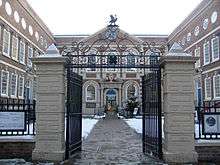 |
1717 | The entrance railings, gates and gate piers of Bluecoat Chambers were built at the same time as the building itself. The entrance consists of decorated and crested wrought iron gates attached to stone gate piers with panelled rustication, entablatures and pyramidal caps. From these, extending in either direction, are two low brick walls topped with iron railings. | 53°24′16″N 2°59′02″W / 53.4044°N 2.9838°W | [22][23] |
| Church of All Hallows | Allerton Road | 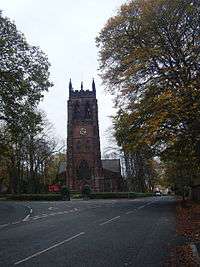 |
1872-6 | The Church of All Hallows is an active Church of England parish church. Constructed from stone with a slate roof, it consists of a four-bay nave with aisles under lean-to roofs, transepts, a western church tower, a chancel with vestry and an organ loft. Most of the church's stained glass windows where designed by Edward Burne-Jones and are considered to be one of the most complete sets by Burne-Jones. The aisle windows are mainly tracery in form and the nave has clerestory windows situated above the lean-to roofs of the aisles. Inside the church the chancel is partly decorated with marble. To the south-east is a mausoleum to the family of John Bibby, who financed the church's construction and whose wife it was built in honour of. It is noted for its angled buttresses and panelled & embattled parapet, as well as its cusped arched entrance. | 53°22′51″N 2°54′13″W / 53.3807°N 2.9037°W | [24][25][26] |
| Church of All Saints | Childwall Abbey Road |  |
C14; C15, C18 and C19 [nb 2] |
All Saints' Church is an active Church of England parish church. Its oldest portion – the chancel – dates from the 14th century, making it the only Medieval church in Liverpool. The Gothic influence is maintained in later additions, such as with the clock tower, which incorporates both gargoyles and tracery windows and is topped by a needle spire. It has a central nave leading to a wagon vaulted chancel, with north and south aisles. It has two chapels, the Salisbury Chapel was built 1739–40, with the Plumbe Chapel built in 1777. Inside, there is a rare painted memorial to Major Pitcairn Campbell, as well as a brass chandelier dated 1737 and Royal Arms of England from 1664. | 53°23′43″N 2°52′53″W / 53.3953°N 2.8815°W | [27][28][29] |
| Church of St. Agnes and St. Pancras | Ullet Road |  |
1883-5 | The Church of St. Agnes and St. Pancras is an active Church of England parish church. It was designed by J.L. Pearson from brick with stone dressings and a tile roof. The church consists of a central aisle with parallel aisles under lean-to roofs, with east and west transepts and a chapel. There is also a first floor gallery with an arcaded balustrade and the interior features numerous angel depictions, as well as stained glass windows designed by Charles Eamer Kempe. The building was described by Nikolaus Pevsner as "The noblest Victorian church in Liverpool" | 53°23′23″N 2°56′23″W / 53.3896°N 2.9398°W | [30][31][32] |
| Church of St. Clare | Arundel Avenue |  |
1888–90 | The Church of St. Clare is an active Roman Catholic parish church. Designed in Neo-Gothic style by Leonard Stokes, the church is brick built with stone dressings and a slate roof. It consists of a single vessel, north and south chapels and a small transept to the north. There are six recessed tracery windows on the northern side and southern sides. The western end has an ornately patterned seven-panel tracery window with broad weathered sills and large chamfered mullions. The east has a five-panel tracery window with relieved arch and weathered sill, with the stained glass depicting the crucifixion and saints. Internally the church is ten bays long with a wagon-vaulted roof supported by deep splayed internal buttresses | 53°23′28″N 2°56′12″W / 53.3910°N 2.9368°W | [33][34][35] |
| Church of St. George | Heyworth Street |  |
1812–14 | The Church of St. George is an active Church of England parish church. It was designed by Thomas Rickman and John Cragg and was constructed from ashlar stone in a perpendicular style common to English Gothic architecture. The church consists of a nave, short chancel and west tower with adjoining low porches. The tower is supported by diagonal buttresses and features clock faces on three sides. The building is noted for its use of cast iron, which was provided by the Mersey Iron Foundry owned by Cragg. The iron was not only used structurally, but also in the tracery windows and arcades. The church also features stained glass windows designed by Shrigley and Hunt. | 53°25′31″N 2°58′17″W / 53.4252°N 2.9714°W | [36][37][38] |
| Church of St. John the Baptist | West Derby Road |  |
1868–70 | 53°25′29″N 2°55′48″W / 53.4248°N 2.9300°W | [39][40][41] | |
| Church of St Michael | St. Michael’s Church Road |  |
1814 | 53°22′36″N 2°56′59″W / 53.3766°N 2.9498°W | [42][43][44] | |
| Liverpool Cathedral |  |
1904–80 | Liverpool Cathedral is the city's Church of England Cathedral and is part of the Anglican Diocese of Liverpool. It was designed in Gothic Revival style by Sir Giles Gilbert Scott and is constructed from red sandstone sourced from a quarry in nearby Woolton. The Cathedral's construction lasted over 75 years, spanning both world wars and the result is that the building standing today is vastly different from the initial design chosen. Today, Liverpool Cathedral stands as the largest cathedral in the United Kingdom and one of the largest in the world. It is regarded as one of the greatest buildings constructed during the 20th century. | 53°23′51″N 2°58′24″W / 53.3974°N 2.9732°W | [45][46][47] | |
| Liverpool Cenotaph | St Georges Plateau | |
1927–30 | Originally a memorial to those who fell in the First World War, the dates of the Second World War were added later. The cenotaph was designed by Lionel Budden, with carving by Herbert Tyson Smith. It consists of a rectangular block of stone with bronze low-relief sculptures on the sides depicting marching soldiers and mourners. | 53°24′31″N 2°58′46″W / 53.40852°N 2.97949°W | [48][49][50] |
| Liverpool Town Hall | Water Street | 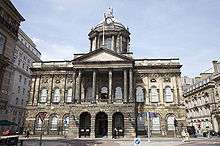 |
1749–54 | 53°24′26″N 2°59′30″W / 53.4072°N 2.9916°W | [51][52][53] | |
| The Oratory | Upper Duke Street |  |
1829 | 53°23′55″N 2°58′24″W / 53.3987°N 2.9732°W | [54][55][56] | |
| Oriel Chambers | Water Street |  |
1864 | 53°24′23″N 2°59′36″W / 53.4065°N 2.9932°W | [57][58][59] | |
| Princes Road Synagogue | Princes Road |  |
1872-4 | 53°23′43″N 2°57′54″W / 53.3952°N 2.9650°W | [60][61] | |
| Royal Liver Building | Georges Pier Head | 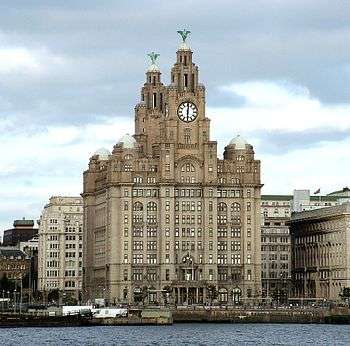 |
1908–10 | 53°24′20″N 2°59′46″W / 53.4056°N 2.9960°W | [62][63][64] | |
| Speke Hall | Speke Hall Road | 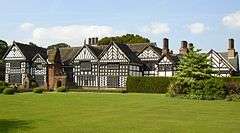 |
1490–1506; 1540–60; 1598[nb 3] |
53°20′12″N 2°52′28″W / 53.3368°N 2.8745°W | [65][66][67] | |
| St George’s Hall | St George's Plateau |  |
1841–56 | 53°24′31″N 2°58′49″W / 53.4087°N 2.9803°W | [68][69][70] | |
| Toxteth Unitarian Chapel | Park Road | |
1618 | 53°22′53″N 2°57′28″W / 53.3813°N 2.9579°W | [71][72][73] | |
| Unitarian Chapel | Ullet Road |  |
1898 | 53°23′23″N 2°56′17″W / 53.3898°N 2.9380°W | [74][75][76] | |
| Unitarian Church Hall | Ullet Road |  |
1901 | 53°23′23″N 2°56′15″W / 53.3898°N 2.9376°W | [77][78][79] | |
| Woolton Hall | Speke Road |  |
1704 | 53°22′17″N 2°51′54″W / 53.3715°N 2.8649°W | [80][81][82] | |
See also
References
Notes
- ↑ The actual list consists of 1471 individual entries, which cover over 2500 buildings and structures throughout the city
- ↑ The oldest portion of the church dates to the 14th century with the aisle and porch believed to be 15th century. Further additions are dated to the 18th century with tower and spire built between 1810–11 and the north aisle dated to 1833. Parts of the church were rebuilt between 1900–05
- ↑ The southern portion of hall was built between 1490 and 1506, with the eastern and western ranges between 1540 and 1560. The northern range is dated 1598
Citations
- ↑ "Historic buildings". Liverpool City Council. Archived from the original on 8 June 2008. Retrieved 21 September 2008.
- ↑ "Grade I listing for synagogue". BBC. 3 March 2008. Retrieved 11 July 2009.
- ↑ Historic England. "Dock Traffic Office, Liverpool (1356264)". National Heritage List for England. Retrieved 25 April 2013.
- ↑ Sharples & Pollard (2004), p. 111
- ↑ "DOCK TRAFFIC OFFICE". Images of England. Retrieved 12 August 2010.
- 1 2 3 "Albert Dock Map" (PDF). Albert Dock Co. Retrieved 21 August 2010.
- 1 2 3 4 Sharples & Pollard (2004), pp. 106–108
- ↑ Historic England. "Warehouse A, Liverpool (1205175)". National Heritage List for England. Retrieved 25 April 2013.
- ↑ "WAREHOUSE A". Images of England. Retrieved 4 May 2010.
- ↑ Historic England. "Warehouse B and C, Liverpool (1068409)". National Heritage List for England. Retrieved 25 April 2013.
- ↑ "WAREHOUSES B&C". Images of England. Retrieved 4 May 2010.
- ↑ Historic England. "Warehouse D, Liverpool (1280847)". National Heritage List for England. Retrieved 25 April 2013.
- ↑ "WAREHOUSE D". Images of England. Retrieved 4 May 2010.
- ↑ Historic England. "Warehouse E, Liverpool (1068410)". National Heritage List for England. Retrieved 25 April 2013.
- ↑ "WAREHOUSE E". Images of England. Retrieved 4 May 2010.
- ↑ Historic England. "Bank of England, Liverpool (1205904)". National Heritage List for England. Retrieved 25 April 2013.
- ↑ Sharples & Pollard (2004), p. 137
- ↑ "BANK OF ENGLAND BUILDING". Images of England. Retrieved 13 August 2010.
- ↑ Historic England. "Bluecoat Chambers, Liverpool (1292322)". National Heritage List for England. Retrieved 25 April 2013.
- ↑ Sharples & Pollard (2004), pp. 177–180
- ↑ "BLUECOAT CHAMBERS". Images of England. Retrieved 13 August 2010.
- ↑ Historic England. "Railings gates and gate piers Old Bluecoat School, Liverpool (1073446)". National Heritage List for England. Retrieved 25 April 2013.
- ↑ "BLUECOAT CHAMBERS – RAILINGS, GATES AND GATE PIERS". Images of England. Retrieved 13 August 2010.
- ↑ Historic England. "Church of All Hallows, Allerton, Liverpool (1068414)". National Heritage List for England. Retrieved 25 April 2013.
- ↑ Pollard & Pevsner (2006), pp. 386–387
- ↑ "CHURCH OF ALL HALLOWS". Images of England. Retrieved 11 May 2010.
- ↑ Historic England. "Church of All Saints, Childwall, Liverpool (1356299)". National Heritage List for England. Retrieved 25 April 2013.
- ↑ Pollard & Pevsner (2006), pp. 397–399
- ↑ "CHURCH OF ALL SAINTS". Images of England. Retrieved 13 August 2010.
- ↑ Historic England. "Church of St Agnes, Liverpool (1359871)". National Heritage List for England. Retrieved 25 April 2013.
- ↑ Sharples & Pollard (2004), pp. 284–286
- ↑ "CHURCH OF SAINT AGNES". Images of England. Retrieved 13 August 2010.
- ↑ Historic England. "Church of St Clare, Liverpool (1205333)". National Heritage List for England. Retrieved 25 April 2013.
- ↑ Sharples & Pollard (2004), pp. 286–288
- ↑ "CHURCH OF ST CLARE". Images of England. Retrieved 11 May 2010.
- ↑ Historic England. "Church of St George, Everton, Liverpool (1075216)". National Heritage List for England. Retrieved 25 April 2013.
- ↑ Sharples & Pollard (2004), pp. 264–267
- ↑ "CHURCH OF ST GEORGE". Images of England. Retrieved 16 August 2010.
- ↑ Historic England. "Church of St John Baptist, Liverpool (1063778)". National Heritage List for England. Retrieved 25 April 2013.
- ↑ Pollard & Pevsner (2006), pp. 477–479
- ↑ "Details for IoE Number: 359734 – CHURCH OF ST JOHN BAPTIST". Images of England. Retrieved 13 August 2010.
- ↑ Historic England. "Church of St Michael, Aigburth, Liverpool (1209945)". National Heritage List for England. Retrieved 25 April 2013.
- ↑ Sharples & Pollard (2004), pp. 293–294
- ↑ "Details for IoE Number: 359420 – ST MICHAELS CHURCH". Images of England. Retrieved 16 August 2010.
- ↑ Historic England. "Anglican Cathedral Church of Christ, Liverpool (1361681)". National Heritage List for England. Retrieved 25 April 2013.
- ↑ Sharples & Pollard (2004), pp. 73–82
- ↑ "ANGLICAN CATHEDRAL CHURCH OF CHRIST". Images of England. Retrieved 17 April 2011.
- ↑ Historic England. "Liverpool Cenotaph (1073463)". National Heritage List for England. Retrieved 12 November 2013.
- ↑ Sharples & Pollard (2004), p. 59
- ↑ Cavanagh (1997), pp. 98–99
- ↑ Historic England. "Town Hall, Liverpool (1360219)". National Heritage List for England. Retrieved 25 April 2013.
- ↑ Sharples & Pollard (2004), pp. 42–48
- ↑ "Details for IoE Number: 359717 – TOWN HALL". Images of England. Retrieved 16 August 2010.
- ↑ Historic England. "The Oratory, Liverpool (1063282)". National Heritage List for England. Retrieved 25 April 2013.
- ↑ Sharples & Pollard (2004), pp. 243–244
- ↑ "Details for IoE Number: 359643 – THE ORATORY". Images of England. Retrieved 16 August 2010.
- ↑ Historic England. "Oriel Chambers, Liverpool (1291943)". National Heritage List for England. Retrieved 25 April 2013.
- ↑ Sharples & Pollard (2004), pp. 171–172
- ↑ "Details for IoE Number: 359719 – ORIEL CHAMBERS". Images of England. Retrieved 19 August 2010.
- ↑ Historic England. "Princes Road Synagogue, Liverpool (1072969)". National Heritage List for England. Retrieved 25 April 2013.
- ↑ Sharples & Pollard (2004), pp. 248–249
- ↑ Historic England. "Royal Liver Building Iron railings and stone piers surrounding Royal Liver Building, Liverpool (1356370)". National Heritage List for England. Retrieved 25 April 2013.
- ↑ Sharples & Pollard (2004), pp. 70–71
- ↑ "Details for IoE Number: 214151 – ROYAL LIVER BUILDING". Images of England. Retrieved 16 August 2010.
- ↑ Historic England. "Speke Hall, Liverpool (1359837)". National Heritage List for England. Retrieved 25 April 2013.
- ↑ Pollard & Pevsner (2006), pp. 463–468
- ↑ "Details for IoE Number: 359547 – SPEKE HALL". Images of England. Retrieved 16 August 2010.
- ↑ Historic England. "St George's Hall, Liverpool (1361677)". National Heritage List for England. Retrieved 25 April 2013.
- ↑ Sharples & Pollard (2004), pp. 49–58
- ↑ "Details for IoE Number: 359391 – ST GEORGE'S HALL". Images of England. Retrieved 16 August 2010.
- ↑ Historic England. "Toxteth Unitarian Chapel, Liverpool (1072991)". National Heritage List for England. Retrieved 25 April 2013.
- ↑ Sharples & Pollard (2004), pp. 274–275
- ↑ "Details for IoE Number: 359221 – TOXTETH UNITARIAN CHAPEL". Images of England. Retrieved 16 August 2010.
- ↑ Historic England. "Unitarian Chapel, Liverpool (1218227)". National Heritage List for England. Retrieved 25 April 2013.
- ↑ Sharples & Pollard (2004), pp. 288–289
- ↑ "Details for IoE Number: 359629 – UNITARIAN CHAPEL". Images of England. Retrieved 13 August 2010.
- ↑ Historic England. "Unitarian Church Hall, Liverpool (1359872)". National Heritage List for England. Retrieved 25 April 2013.
- ↑ Sharples & Pollard (2004), p. 289
- ↑ "Details for IoE Number: 359630 – UNITARIAN CHURCH HALL". Images of England. Retrieved 13 August 2010.
- ↑ Historic England. "Woolton Hall, Liverpool (1217943)". National Heritage List for England. Retrieved 25 April 2013.
- ↑ Pollard & Pevsner (2006), pp. 509–510
- ↑ "Details for IoE Number: 359555 – WOOLTON HALL". Images of England. Retrieved 16 August 2010.
Sources
- Cavanagh, Terry (1997), Public Sculpture of Liverpool, National Recording Project, Liverpool: Liverpool University Press, ISBN 978-0-853-23711-2
- Pollard, Richard; Pevsner, Nikolaus (2006), Lancashire: Liverpool and the South-West, The Buildings of England, New Haven and London: Yale University Press, ISBN 0-300-10910-5
- Sharples, Joseph; Pollard, Richard (2004), Liverpool, Pevsner Architectural Guides, New Haven and London: Yale University Press, ISBN 0-300-10258-5
